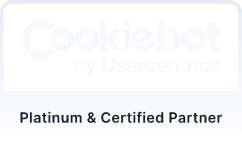Summary
In this article, we’ll outline the end-to-end steps of what takes place in a thorough user experience (UX) and user interface (UI) web design process and discuss what modern web design requires to be successful.
—
You may have read our in-depth guide to creating a brief for a web design and development project. A brief can be used to capture all your ideas and requirements before discussing your project with any web design and development agencies.
Once you’ve completed your brief, and evaluated your options for agency partners, you’ll be ready to launch into your website project.
An end-to-end website project is typically organised into phases, which will usually be structured as follows:
- Design
- Development
- Quality Assurance Testing
- Migration and Launch.
We’ve provided a detailed breakdown of these phases in a recent series of articles. This series is intended to give you a clear understanding of the full end-to-end process involved when working with an agency to design and develop a website. This will help you remove any apprehension heading into this kind of project and set you up for success.
The Current State of Web Design
“Design is not just what it looks like and feels like. Design is how it works.”
Steve Jobs, Co-Founder and former CEO of Apple.
While web design does focus on the visual aspects of the site, there’s a lot more to it than just the aesthetic elements like colour schemes and typography.
Web design is a complex blend of branding, user experience (UX) design, user interface (UI) design, graphic design, content creation, layout and structure, accessibility, and much more.
The design of your website needs to be visually attractive but, more importantly, it also needs to be simple and easy-to-use. Your website needs to find the perfect balance between supporting your strategic objectives and serving your clients with a seamless experience. Of course, that’s much easier said than done, which is why it’s so important to find an experienced partner you can trust to guide you through the process.
Outlining the Web Design Process
Phase 1 – Research and Planning
The phase that underpins EVERYTHING!
A good agency will have absorbed everything in your project brief. They should also have worked hard to understand your perspective and your requirements from your website, before you’ve even agreed to work together.
Once you’re preparing to launch the project, the research and planning phase will then go beyond that initial information gathering exercise.
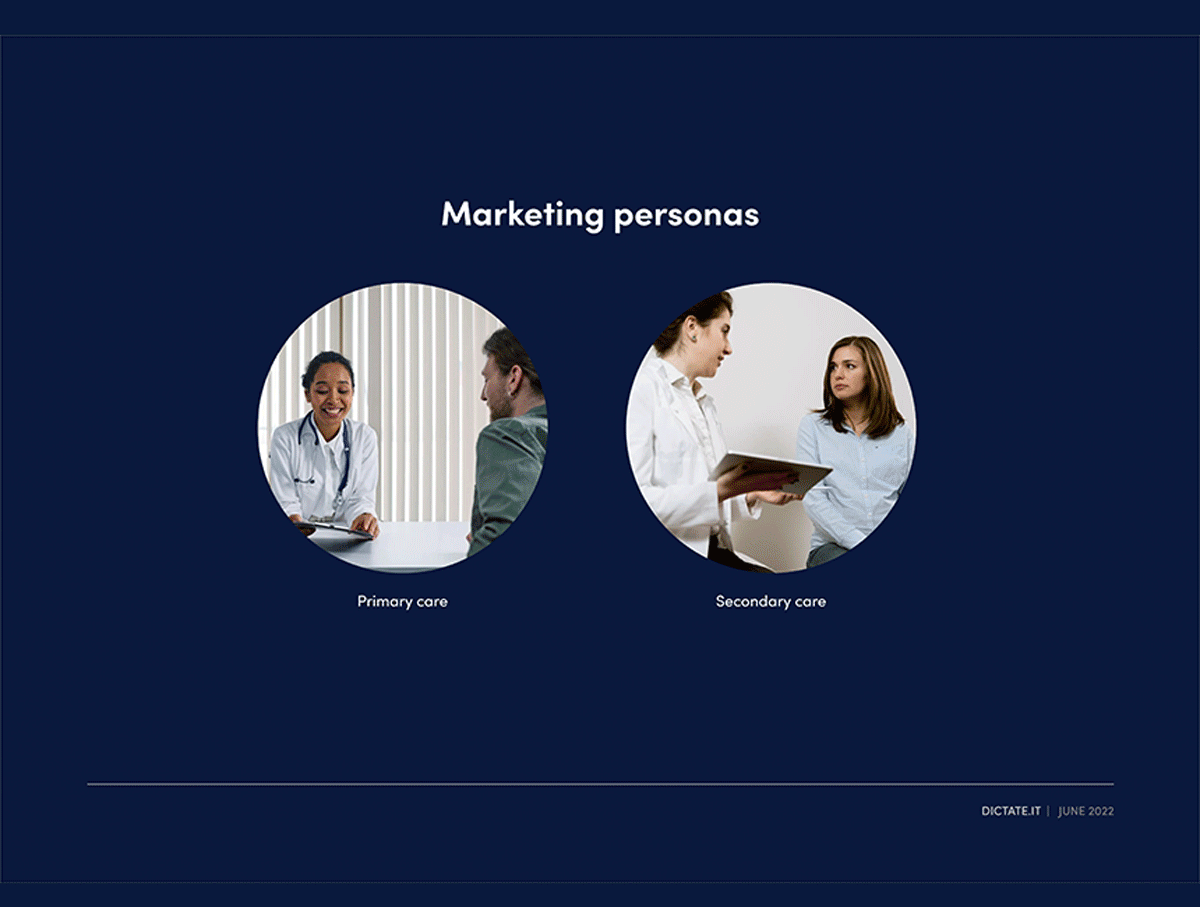
The objective of this phase is to define the full scope of the website, including its design, its features and functionality, its content, and everything else involved.
Your site will be discussed in extensive detail, and then research will be conducted into some key areas that will inform your design and development, such as:
- Strategy
- Website Data
- Target Audience
- Industry Landscape
- Competitors.
Whether you’re making small updates to an existing design or completely rebranding your business, it’s equally important to use this research to inform every decision you make. That’s because every element of your site’s design must be made to support your business goals and serve your target audience with a great user experience (UX).
This research and planning phase is essential in enabling you and your agency partner to do that.
Phase 2 – Visual Exploration
This exploratory phase involves defining the most appropriate and effective visual direction to take with your site.
The main tool used to help determine the right visual identity for your website is a set of mood boards. These are a visual compilation of different options for colour, typography, structure, images, and other visual components that are used to tell your brand’s story through your website’s design.
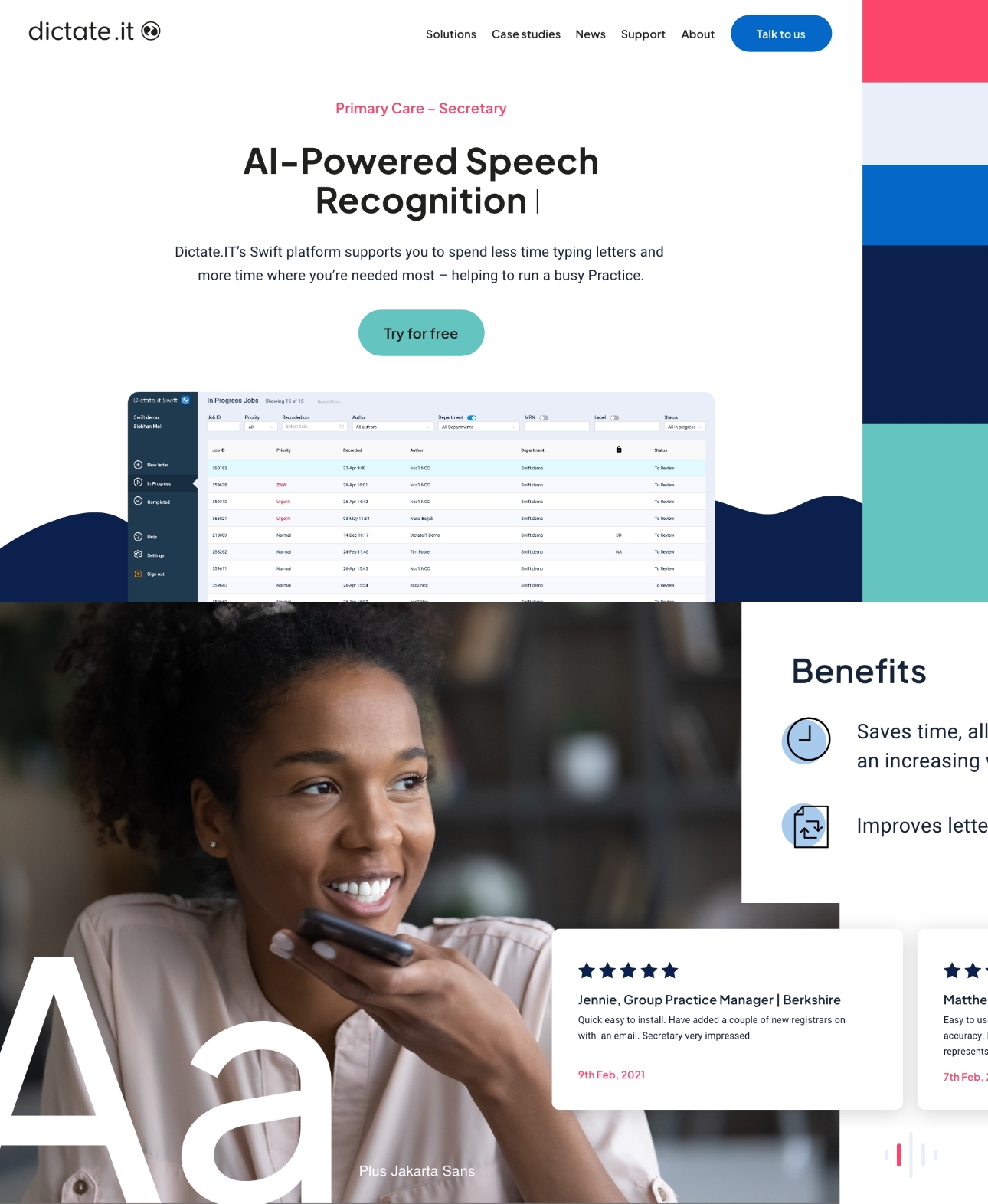
A good agency partner will usually present around three mood boards to help shape the direction, then collaborate with you to narrow it down to one final version.
Visual exploration, like most processes within web design and development, will be collaborative and iterative. You’ll be presented with ideas by your agency partner, then given the chance to provide feedback across several rounds of revisions.
Phase 3 – User Experience (UX) Design
The UX design process is the phase in which you work with your agency’s UX specialist to create a blueprint of the website functionality.
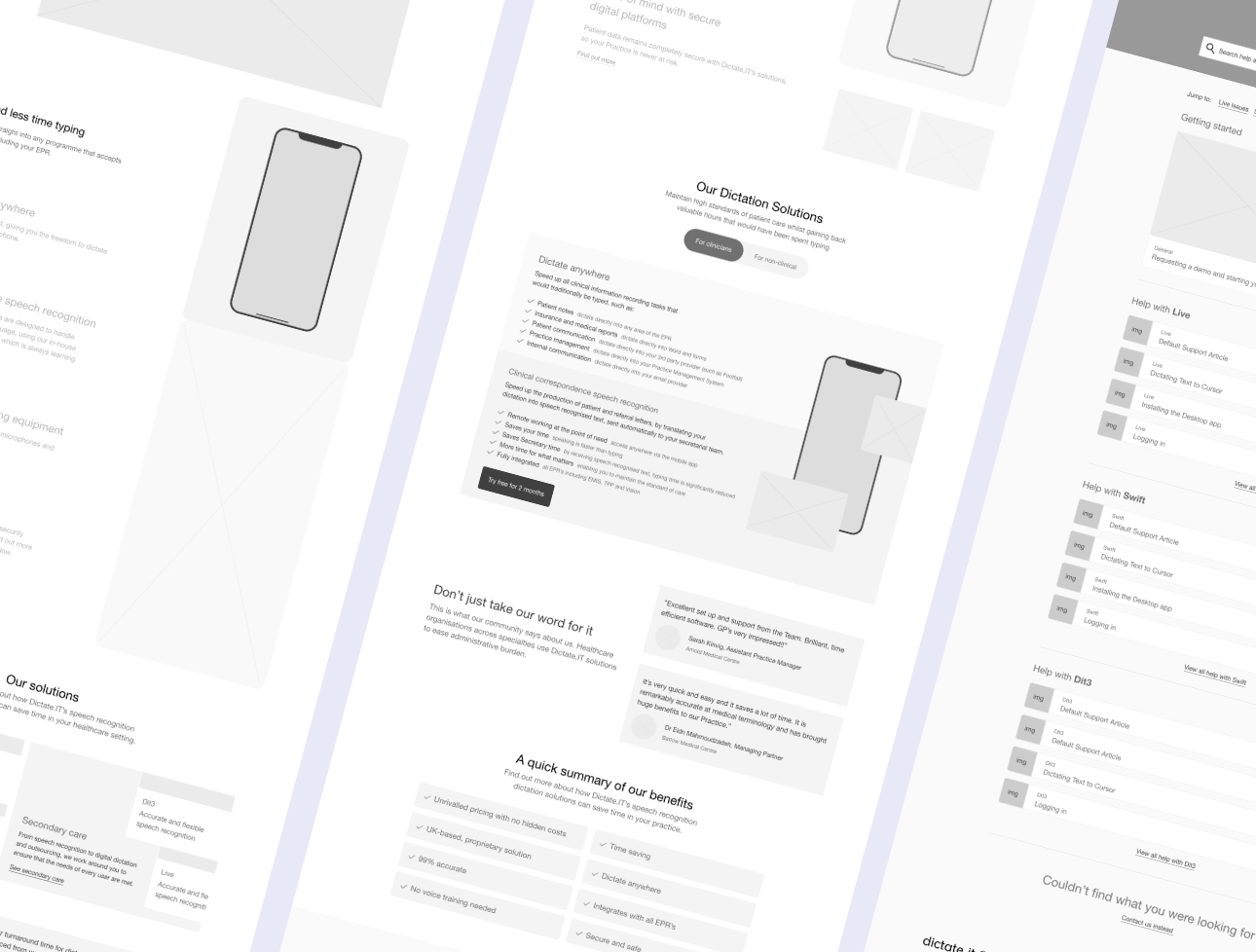
This involves creating wireframes (either low-fidelity or high fidelity) that help you visualise the design and outline your website visitors’ flow through the pages into your main calls-to-action. This is the way the website’s design works strategically to drive outcomes that align with your business goals.
This phase takes place before working on the site’s visual design to ensure the two separate aspects complement each other.
Phase 4 – User Interface (UI) Design
From there, your user interface (UI) will be designed. The styles, fonts, and look and feel of the site from the mood boards will be applied to the wireframes.
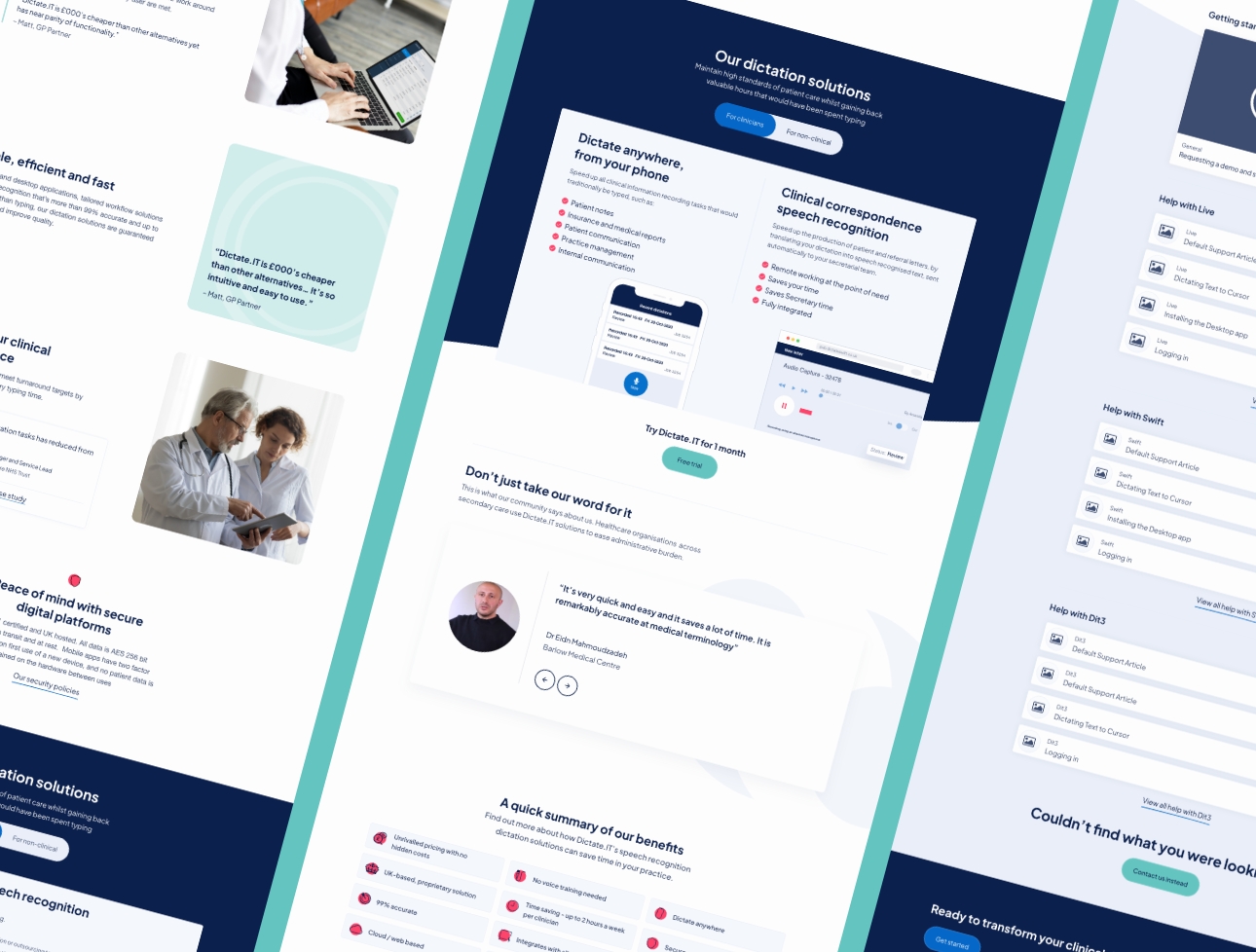
Your agency will likely present you with a design for your homepage before moving on to the rest of the site. This will typically be done on a desktop screen size, but it can be done on mobile if you want to take a mobile-first approach. Once this is complete, it will then be designed across the relevant breakpoints.
After completing this process, your agency partner will be ready to enter into developing your website.
Making Complex Processes Simple
As technology continues to become more advanced, more and more of our daily lives now take place in a digital-first context. This means:
- Your target audience now has a shorter attention span, and less patience when browsing websites and services online
- Your target audience also has more choice of options than ever before when choosing who to buy from.
In order to succeed, your website’s design requires careful planning, research, and a strategic approach if it hopes to meet the demands of the modern client.
Working with a specialist design and development agency is a proven approach to ensuring you gain a website that meets your requirements and delivers on the expectations of your target audience.
Completing a process like the one outlined in this article will enable you to design a website that can become your clients’ go-to online source when they have a need.
As mentioned earlier, we’ve provided a step-by-step guide to each of these phases to make the process even easier for you.
Would you like these insights straight to your mailbox?
- Brainstorming and ideation
- Assistance in research and information-gathering
- Writing copy
- Writing code
- Image and video creation
- Data analysis
- Automating manual processes.
- GPT-4 was released as an upgrade to Chat GPT. GPT-4 can understand images, process 25,000 words in one go, earn a top 10% score on complex exams, and even demonstrate some advanced reasoning capabilities.
- Adobe released Firefly, which is a programme with a range of new generative AI features. It can create outstanding new content using simple language, with almost-unlimited creative options like turning 3D compositions into photorealistic images and automating advanced video editing processes.
- GitHub launched CoPilotX, which can supposedly boost coding speed by up to 55%. CoPilotX has similar features to Chat GPT, but will be used by software engineers and developers to boost productivity and time-to-market.
- And, just last week, Stability AI released its Stable Diffusion XL model, offering photorealism through an intricate editing interface. It’s reportedly built with around 2.3 billion parameters.
- What’s the purpose of your project?
- What objectives do you want to achieve?
- What exactly are you looking to build?
- How much budget do you have to spend?
- What existing technology do you need to integrate with?
- What features and functionality do you need?
- What skills and expertise do you have in-house?
- Stick with your existing platform and update or build on to it
- Buy a custom, purpose-built, ‘out the box’ platform or piece of software
- Work with an agency to adopt a new platform and/or build something bespoke.
- Bespoke development
- Customisable design, features, and functionality
- Migration from legacy systems to a new platform
- Seamless scalability
- A secure infrastructure
- Performance in peak traffic volumes
- Integration with back-end systems like Salesforce, HubSpot, PowerBi, and more
- Ease-of-use in both the front and back-end
- Quick and easy editing capabilities
- Multi-site development for multiple languages across different countries
- Responsive or ‘headless’ design for web and mobile, enabling omni-channel customer experience.
Industry News
25 April, 2023
The Changing Roles of Web Design and Development in the Age of AI
Summary
In the first few months of 2023, generative AI has burst on to the scene and begun to change our relationship with technology forever. Already, there’s plenty of evidence to suggest that people in a wide range of jobs will have to adapt quickly or risk being replaced. In this article, we explore the impact AI is having on the web design and development industry, as well as how businesses, and people, should approach working with this innovative technology.
———
AI tools are nothing new. We’ve all been using them for years, from chatbots to predictive text to voice-controlled assistants like Siri and Alexa. But the recent mainstream adoption of AI tools such as Chat GPT, and the rapid advancement of the technology itself, has caused huge disruption across a number of industries.
Many assumed that people like marketers, software developers, and UX and UI designers would be some of the last ones at risk of having their jobs taken by AI, due to their need for creative skill and use of human emotion. Ironically, these roles have been some of the first to come “under threat” over the past few months.
AI’s speed and efficiency is already forcing us to ask questions about the future of the web design and development industry. With that in mind, one question in particular has dominated discussion online so far this year:
Are our jobs in danger of being taken by AI?
By now, you’re almost certainly aware that AI offers incredible value by accelerating workflows and augmenting skills. Some of the most beneficial use cases lie in:
AI can also devise entire business and marketing strategies, solve complex problems, and even create its own AI-powered applications from scratch. Perhaps most importantly, it can do all these tasks in a matter of seconds, when most of them would take a human several hours, days or even months.
The Latest News and Tools (at the Time of Writing)
Over the past few months, there are more and more AI-powered tools being released on an almost daily basis.
The number of AI tools that have been released recently is staggering, and the capabilities of some of them is truly mind-blowing. Just last month, in March 2023:
It’s both exciting and terrifying to think these highly intelligent tools are just the tip of the AI iceberg. When you consider how common it’s now become to use AI to develop even more advanced AI, it seems that the rate of evolution will only continue to increase exponentially from here.
How is AI Transforming Design and Development?
While these AI tools are extremely impressive, it’s not as straightforward as simply plugging them in and sitting back while they literally do your work for you. It’s possible we may get there one day, but right now we believe we’re a long way off.
These tools are highly sophisticated and intuitive, and their adoption is probably going to change the way we all work forever. However, this should be seen as technology that will augment and enhance people’s ability to do their jobs, or create new jobs entirely, rather than “steal” them away from us.
The current use cases for AI are mostly just ways for you to do your work, much faster and more effectively. This could either be done by automating processes to save time, or by supplementing your existing skill-set with new capabilities with the help of AI. For example, if you wanted to convert your code from one language into multiple languages, you would be able to do this with the help of Chat GPT.
When it comes to user experience (UX) design, one crucial thing AI will always be missing is human empathy, emotion, and understanding. A company looking to create a high-performance website that supports their strategic business goals and engages their target audience will fail if they don’t take into account human understanding and collaboration between them and their web development agency.
Outlining the What and the How is important, but the Why is arguably what drives great UX and UI.
“Design is not just a visual experience, it’s an emotional one. It should make people feel something.”
Nathan Shedroff, Author and Professor of Design Strategy
UX design is a nuanced, collaborative process, focusing on the specific requirements of the business and the specific needs of the target audience. You can save a lot of time using AI to produce a high volume of early conceptual designs or accelerate your copywriting process. But without the human element, none of these things will be authentic or anywhere near the required standard.
Potential Concerns and Risks with AI
Of course, we’ve not even mentioned the rising concerns and risks associated with AI yet. Just last month, over 1,000 technology leaders and influencers signed a petition to halt the development of generative AI until more governance can be introduced to ensure its safety.
There are still some serious grey areas regarding the use of this technology in business as well, from regulations and legal implications to the copyright of creative work like logos and images. These are providing opportunities for a wide range of new forms of cyber crime, phishing, and “deep-fake” imitations which could spiral out of control if left unchecked.
There are also plenty of moral issues surrounding AI that we must consider. For example, what implications will there be for our society if global businesses do begin replacing humans with AI on a large scale?
A key concern is that Generative AI is also having a significant impact on the environment, which is a conversation most people seem to be avoiding for the time being. With the global fight to reduce carbon emissions intensifying, and more businesses placing sustainability at the core of their values, there needs to be some action taken to balance those priorities with the efficiency and speed enabled by AI.
The SoBold Perspective
From our perspective, as a leading design and development agency, we believe that people will always want and need to work with other people. Personable relationships, real-life experience, and critical thinking are all essential parts of our work. In many cases, that’s also what many of our clients value most about our services.
Granted, we’re always looking for innovative new ways to push the boundaries, and AI is an incredible tool that will help us do that. But it won’t replace crucial human characteristics like empathy, emotion, and subjective opinions.
It will, however, help us spend less time on low-value tasks, and more time to focus on building stronger relationships and gaining a deeper understanding of our clients’ needs. That will only result in improving the work we deliver, which is something we’re always striving to achieve.
The Verdict on AI (for Now)
This year will probably be looked back on as a turning point in history when AI was introduced to the world. But this technology won’t replace too many jobs just yet. Instead, it will enhance our ability to work smarter, faster, and more efficiently.
For now, the only people at risk of losing their jobs to AI are those who fail – or refuse – to adapt to this new way of working and embrace the change. Similarly, if you’re using AI because you’re being lazy or complacent, that will also cause problems. You should never use work produced by a generative AI tool without checking its quality and accuracy, and you’ll always need to add a human touch before considering it finished.
On the other hand, if you’re forward-thinking and agile, embracing AI will make you exponentially better at your job. Here at SoBold, we’re personally most excited by how AI has the potential to help us vastly improve the service we deliver for our clients.
Of course, this technology is evolving so fast that it’s difficult to predict where we’ll stand a year from now. We’ll be discussing this, and lots of other important trends, in our new monthly newsletter.
Would you like these insights straight to your mailbox?
Announcement
22 November, 2022
SoBold become only 3rd Platinum Certified Cookiebot Partner in the UK
SoBold are delighted to become only the 3rd Platinum Certified Cookiebot Partner in the United Kingdom.
Cookiebot consent management platform (CMP) is a leading compliance solution that detects and controls all cookies and trackers in use on a website, and automatically manages end-user consents.
SoBold have been working closely with Cookiebot since the new General Data Protection Regulation (GDPR) came into place on 24 May 2018 providing their clients with transparency and control over the cookies used on their websites. Since partnering with Cookiebot as a reseller, SoBold have worked with clients including Transport for London and the London Transport Museum to develop bespoke implementations of the Cookiebot CMP. More information on SoBold’s work with Transport for London can be found here.
In October 2022, Cookiebot launched a tiered partner and certification program. As a leading Cookiebot reseller SoBold has been named as a Platinum Certified partner, highlighting its expertise with the Cookiebot platform and data privacy compliance in general.
By becoming a Platinum Certified Cookiebot Partner, SoBold will be able to continue to offer more support to leading businesses needing bespoke Cookiebot solutions.
Cookiebot Sales & Channel Manager, Grant MacInnes said:
Congratulations to Sam Phillips & SoBold on joining our very elite group of platinum certified resellers. Looking forward to continuing to work closely with you and the team over the coming months and years.
SoBold Technical Director, Sam Phillips said:
By becoming just the 3rd Platinum Certified Cookiebot partner in the UK we have continued to cement our position as a leading Cookiebot reseller. Having been one of the first resellers of Cookiebot in 2018, our partnership with Cookiebot continues to go from strength to strength and we are looking forward to developing more bespoke implementations for Cookiebot’s enterprise user base as a fully certified partner.
Would you like these insights straight to your mailbox?
Digital Business
2 March, 2023
Harnessing Your New Website’s Full Potential by Taking a Block-Based Approach With WordPress
Did you know you can use a block-based approach with your WordPress website to gain more value from the platform, with significant advantages in flexibility, scalability, and ease-of-use?
In this article, we’ll explain what blocks are, how they work, and how you can use them to build enterprise-grade websites quickly and efficiently, without compromising on quality.
—
WordPress is the most popular content management system (CMS) in the world right now, and it has been for a while. Unfortunately, though, some people still have the wrong impression that it is a CMS that can only be used to build more simple websites that do not have any real complex functionality or integrations, but this couldn’t be further from the truth.
In fact, WordPress is far more intuitive and robust than most realise. The fact that around 45% of all websites online today are built on the platform goes a long way to prove that. WordPress also provides more scalable, agile capabilities that are perfectly suited to building enterprise-grade websites if leveraged in the right way.
There are intelligent – but still very straightforward – ways to use WordPress that can unlock more value from the CMS. If done with the right guidance, this can make WordPress a far better option than the more traditional, rigid approach of building websites.
This is an opportunity most large businesses are currently missing out on. In this article, we’ll show you how using blocks is a more flexible approach that can provide you with a wealth of benefits.
Understanding How Using Blocks In Your Website Backend works
In 2018, WordPress released a new block-based design and editing user interface (UI), known as Gutenberg. Instead of the typical page creation and editing functionality of a CMS, where you’d input text and images into a rich text editor, you can now build your site by creating and using a set of components. Components are blocks of code which have pre-defined style and input types.
Each component is named, to denote what it is from the perspective of the front-end of your site on the web page.
Note: Some agencies only provide a list of block names, but here at SoBold we also provide screenshots of each block so you can see it first. This makes the process much easier and saves you a great deal of time.
Each part of each web page is made up of these components, as pictured below.
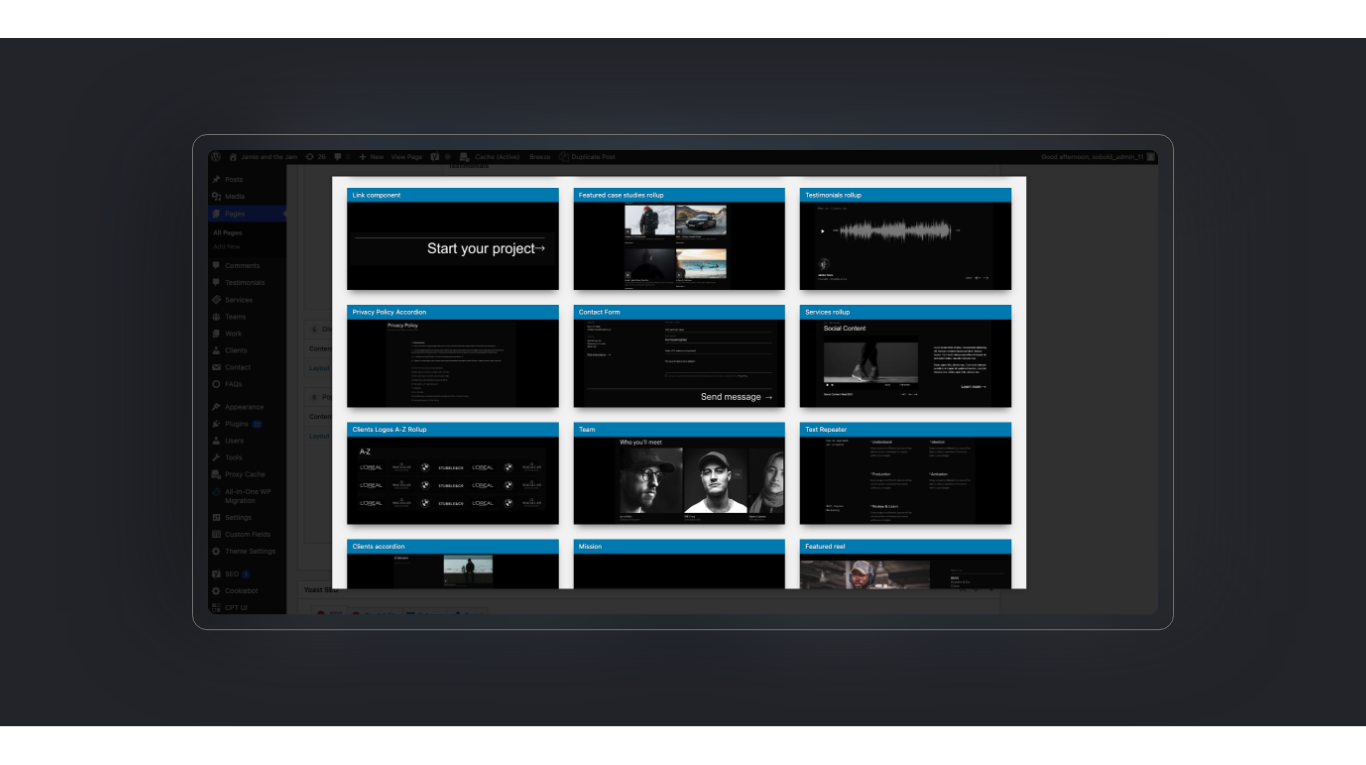
However, taking a bespoke approach, you can design and construct unique blocks that are entirely your own. Blocks or components can be built for you by your agency so they’re bespoke to you, your style guidelines, your design preferences, and so on. And, when building your site, you can go into your pre-built components and edit things, like changing background colours, adding images, adding text, and so on.

This can be set up for you by your agency, so you have everything you need to create, edit, and publish new pages with your pre-built blocks. Anytime you need to create a new page, you just have to pick the appropriate components and place them in the correct position to quickly and easily build the page.
The Business Benefits of Using a Component-Based Approach
Scalability
Scalability is one of the greatest benefits of using these blocks, especially if you are wanting to continue to build out your sitemap and build out the content.
This scalability is where WordPress really shines, enabling simple, rapid, virtually limitless scaling of your website with a high level of accuracy. This is a cost-effective way of growing without having to compromise on the quality of your design.
Flexibility
Blocks provide you with a great deal of flexibility in building, editing, and structuring of pages as well. The ability to customise all your components, along with the intuitive drag and drop functionality, allows you to effortlessly adapt and expand on your website.
Efficiency
Building components, and repurposing them repeatedly across your website, is a highly efficient way of growing your site. It also makes it very difficult to make mistakes or take a wrong turn.
This efficiency of reusing blocks across your website will free up time for you to develop innovative new features, or focus on improving the service and experience you provide your clients.
Ease-of-Use
If you have non-technical members of your team who would benefit from using WordPress, blocks will almost certainly improve the usability of the CMS for those people.
An easier design and editing function helps more members of your team create web pages within clear, pre-set brand guidelines. That’s another aspect that frees up more time and resources to focus on higher value tasks.
If you’re working with a design and development agency, this also makes it much easier for them to be able to train you and enable you to use the platform to manage your site.
Faster Time-to-Market
All this efficiency and ease-of-use will enable you to achieve a faster time-to-market for new web pages, extensions of your site, or even entirely new websites.
That can, in turn, create competitive advantages for your business, particularly if your competitors are working with CMSs that are slower and harder to use.
Whether it’s you or your agency handling this, you can create and publish new web pages quicker than you could with any other approach.
Lower Costs and TCO
As a result of all of the above, you can reduce costs on development and design, and achieve a much better total cost of ownership (TCO) with the WordPress platform.
Something that takes an inexperienced agency days to complete with the classic design approach can be done in hours using bespoke blocks. This drastically reduces development costs and gives you a lower TCO in the long-term.
The Importance of Finding a Capable Agency Partner
As mentioned earlier, bespoke blocks provide you with a proven way to unlock more potential with WordPress and gain greater value from the platform. However, in order to do that, it’s important to find the right agency partner. You’ll need an agency with enterprise-grade expertise and a certain level of skill to guide and support you through this process.
Taking this approach to building WordPress websites is nothing new, but the real value here comes in creating blocks that are completely unique and specific to you, then enabling your team to use those to scale your site.
Many WordPress agencies may lean on the generic block editor. But to get this right, you should push beyond that to find a partner who can educate you on the opportunities of using a bespoke design system to build a high-performance website that’s effortless to manage and edit.
A great partner will also facilitate this for you in a way that ensures you have control, removing the risk of any users making mistakes with the flexibility of this system. You won’t need to worry about the integrity or quality of your site being spoiled because all your components will be built specifically to prevent that.
You’ll gain tremendous value from receiving an intuitive, quality website that you can easily grow at will, but one that’s also managed and supported by an experienced partner. Sticking to these blocks helps you stay within brand guidelines, adhere to best practices, and keep your site consistent.
You then have the choice to manage, edit, and expand your site yourself, or rely on your partner to do it for you quicker, easier, and more efficiently than they would with a traditional CMS.
Making the Most of Your WordPress Platform
Modern businesses today require a powerful, sophisticated CMS that can deliver great websites at scale with enterprise-grade performance. WordPress is a platform that’s built to provide all those qualities and more. Embracing this block-based approach is the most effective and efficient way to achieve that.
With a skilled agency partner to help you maximise the value your business gains from the platform, you’ll quickly realise just how well WordPress can deliver agile, intuitive websites.
If you’re in the process of evaluating platforms to deliver a bespoke web development project, check our comprehensive guide to assessing and selecting the right CMS here
Would you like these insights straight to your mailbox?
Digital Business
31 October, 2022
Understanding and Evaluating Enterprise Options for Bespoke Web Development
Evaluating and selecting the best option for a bespoke web development project is an important decision, with a lot riding on it. But with so many technology providers, platforms, and agency partners out there today, that decision can be overwhelming.
In this article, we’ll guide you through this evaluation process, explore the options available, and help you choose the right technology platform for your own web development project.
We all know that a large business or enterprise relies on technology to function. With dozens of sites across different countries, hundreds of employees, and thousands of customers, technology is the heartbeat of your organisation.
You need sophisticated technology to facilitate mission-critical digital assets like your website, mobile applications, staff portals, communications channels, and various other systems. Many businesses also leverage technology to facilitate processes or capabilities that are entirely unique to the organisation, like internal training platforms or bespoke tools for certain departments.
With that in mind, it’s important to find a platform that can meet your specific requirements and enable you to accomplish your strategic objectives.
Modern enterprise systems need to be dynamic, scalable, and intuitive, and achieving that involves some complexity behind the scenes. For that reason, it’s often necessary to take the route of a bespoke development project to ensure your business gains exactly what it needs in terms of both functionality and capability.
A content management system (CMS) is the most common technology platform for businesses to deliver these projects, with almost two thirds (63%) of all sites on the Internet powered by a CMS today. This is a type of software used to build websites and similar systems, allowing you to easily create, edit, and publish digital content across a range of online channels and devices. But determining the best CMS, let alone choosing the right one for your own bespoke development project, can be a daunting challenge.
So, let’s explore the situations in which it’s wise to adopt a CMS to deliver a development project. We’ll then walk you through the next steps, giving you the confidence to make the best decisions for your business along the way.
Enterprise Challenges with Technology
There are plenty of situations in which a marketing team might be struggling to identify the right technology platform for a project like this.
Perhaps you need to find a way to deliver something very niche, like building a new website or internal system from scratch. Maybe your project requires you to build a website on a new platform, and that platform needs to integrate with your internal systems like Salesforce, HubSpot, PowerBi, and other back-end applications.
Or, you may be trying to solve a challenge, like finding a suitable way to replace your current legacy systems. If, for example, your current website is built on a CMS like Drupal, and it’s no longer capable of meeting your requirements, you’ll need to find a new platform and migrate everything over.
A CMS is an ideal solution in each of these scenarios, and many others. Of course, with such a vast technology landscape to navigate, finding the right CMS is no easy task. It’s even difficult to know where to begin for most enterprise marketers.
So, let’s take a look at how you can approach this evaluation process in a cost-effective, efficient way.
How to Approach an Enterprise Web Development Project
Firstly, as an aside, it’s important to regularly review and reassess whether your CMS is fit for purpose, even if you don’t have an immediate requirement for something new.
Modern technology is advancing so rapidly. With that, your users’ expectations – both employees and customers – are evolving as well. You need to keep up with the pace of change and ensure your technology can still meet the current demands it faces from those users.
Back to the task at hand, though. Before you begin looking into different CMS, you should try to define exactly what it is you need from them.
Whether you’re building a bespoke website or migrating an existing site to a new platform, make sure you know exactly what you want to achieve by doing so.
Start by asking questions like:
Make sure you have a very specific brief and clear set of requirements to take to whichever solution providers and agencies you’ll be speaking to. If you don’t, you’ll struggle to fully understand whether the platforms you’re evaluating can actually deliver what you need.
Once you’ve got that, you can decide which approach is the best for your project. This could be:
It’s worth noting that most web development projects for large businesses will have complex requirements that are almost impossible to achieve without strategic guidance and ongoing support from an experienced partner. An agency partner will work closely with you to understand your strategic objectives and requirements, then provide you with platform-specific skills, tools, and expertise to achieve those. We’ll look at this in more detail later in the article.
Defining Your Requirements
As mentioned above, it’s important to have a specific set of objectives for your project and know what requirements are necessary to achieve those. These will also ensure the partner or agency you work with understands your brief and is able to deliver the exact finished product you’re looking for.
When scoping this out, there are some common capabilities and qualities most enterprise-grade platforms should have in order to meet expectations. Here are some things you should ensure your new platform – and the agency you work with, if you decide to go that route – can provide for your business:
Your Options for Enterprise CMS
Drupal
Drupal is popular among enterprises because it’s a highly secure platform. It’s also great if your team contains technical resources with good coding ability, as it’s very intuitive for people that have more advanced content management skills.
On the other hand, Drupal can be very difficult to get up and running, and is lacking in terms of simplicity. Because of this, your agency costs will also likely be higher than with other CMSs if you take that route.
Even if you do have that technical skill in your team, however, the platform itself is somewhat limited with customisation. It’s also worth noting that the version of Drupal most businesses currently use (Drupal 7) is soon reaching end-of-life. This has caused many Drupal users to migrate their existing sites to new, more intuitive platforms, such as WordPress.
Sitecore
Sitecore is a robust CMS that provides more capabilities than the average platform. It’s popular because it actually offers a fully-managed ‘digital experience platform’ that delivers most of the qualities mentioned in the previous section.
Sitecore comes with a good level of personalisation and is well suited for bespoke development projects. However, it’s an expensive system, requiring the procurement of licenses to begin using it. It also restricts certain capabilities unless you progress to higher tiers (and costs) of your licenses.
From a practical perspective, Sitecore operates on quite hierarchical, complex workflows, which may not suit more agile or smaller teams.
Umbraco
The scalability of Umbraco is great for large organisations, as it allows you to manage a high volume of pages and build out your website to meet the changing needs of your business.
Similar to Drupal, Umbraco is mostly suitable for users with more advanced content management skills and some development experience. This makes it difficult to use for the average marketing team, which increases the likelihood of higher costs, either through more expensive agency projects or even the need to hire someone in-house.
WordPress
WordPress is the platform that powers almost 45% of the world’s websites. It’s so popular because it’s affordable, flexible, dynamic, and very easy to use.
There is a common misconception that WordPress isn’t robust or scalable enough for large businesses. However, this continues to be proven as a myth, as some of the biggest brands in the world are now using WordPress for their CMS, from Nike to Bloomberg.
We’ll provide a detailed breakdown of the benefits and advantages WordPress offers in the next section.
Which is the Best Option?
It’s important to remember every web development project will be different, and each of these platforms are good options in their own way. That’s why you should make your decision based on the solution that best aligns with your objectives, requirements, budget, and other factors.
One common point related to all these platforms that’s worth noting is that each of them are exponentially easier to use, and will deliver far greater return on investment (ROI), if you have the support of an experienced specialist partner to guide you. An agency with platform-specific skills and expertise will ensure your business gains the maximum value from the platform you select, and help you leverage it strategically to harness its full potential.
Business Benefits and Opportunities with WordPress
Using WordPress is an excellent option for any business. For large organisations in particular, there are a number of qualities that make it particularly beneficial.
Scalability and Agility
The WordPress platform is highly scalable. This means that the size and complexity of your website, and the amount of traffic passing through it, won’t be a concern. WordPress can also grow with your business and easily adapt to continue meeting your changing needs. Scalability is one of WordPress’s most prominent advantages for enterprises.
Low TCO and Strong ROI
Of all the options listed above, WordPress comes with the lowest total cost of ownership (TCO). Unlike most platforms, you won’t need to bolt on new features or capabilities with WordPress, nor will you have to worry about costly extra work to manage platform upgrades or updates. Additionally, because WordPress is so flexible and rich with dynamic features and capabilities, it’s proven to deliver strong ROI.
Flexibility and Customisation
WordPress is ideal for a bespoke development project because it’s highly customisable. You can use its flexibility to build bespoke features and functionality into your website or create an entirely unique system.
Fast Time-to-Market
Because of its great usability and simplicity, WordPress allows for a very fast time-to-market, meaning you can deliver your project quickly and efficiently. However, it should be noted that most businesses will need the support of a skilled agency to be able to achieve that.
Integration
WordPress is very easy to integrate with other systems, such as HubSpot, Salesforce, and others. This means your business will experience minimal disruption due to integration, whether migrating to WordPress or starting a new development project from scratch.
Usability
In the back-end, WordPress is renowned for its usability. As a CMS, it’s extremely easy to use, meaning you can get up-to-speed quickly and share responsibilities across more members of your team.
Performance
The performance, speed, and ease-of-use with WordPress are all enterprise-grade when building websites on the platform. This means user adoption and retention will be high, ensuring the success of your project and driving greater ROI.
Long-Term Value
When working with WordPress, you’ll also gain advantages that will deliver added value to your business, especially if you have the support of a specialist partner who can help you unlock the full power of the technology.
The project doesn’t stop with the initial implementation of WordPress, either. As your requirements change, or your project evolves, WordPress is the best platform to adapt with you and deliver value to your business in the long-term.
Why WordPress is the Future of the Enterprise
WordPress is the most popular and widely used CMSs in the world today. And that popularity has been consistently spreading into the enterprise market over the past decade or so.
This is no coincidence, either. It’s unsurprising to see how quickly WordPress is growing in popularity, as more and more businesses realise the vast potential of the platform and the benefits it can deliver.
When taking into account its unprecedented scalability, flexibility, and usability, not to mention its low TCO, WordPress is one of the leading options for bespoke web development projects for large organisations.
When it comes to evaluating the options for your own project, remember to carefully consider how each platform aligns with your requirements and objectives. Once you’ve identified the CMS that is most suitable to deliver what you’re looking for, consider the value that could be added to your project by working with an agency partner who specialises in that technology.
Would you like these insights straight to your mailbox?
Latest from agency
3 August, 2022
Celebrating 3 years with Leonardo Esposito
A fresh-faced Leo joined SoBold in August 2019, with a big booming smile and speaking in broken English. It was immediately clear how driven he was to learn and pick up new skills and it was a no-brainer to offer him a job to join our development team.
For much of his first year at SoBold, Leo was glued to Google Translate to try and properly understand the tasks he had been set, but each and every time the output of his work would be the same, outstanding.
As Leo’s English picked up, as did his confidence and skill-set and he made it clear that he wanted to focus on Back-End Development and he really wanted to take SoBold forward. Leo championed innovation in our development approach and much of the workflow we do today has been driven by Leo’s desire to set the highest of standards.
He is a key figure at SoBold and we are very fortunate to have him.
We caught up with Leo to find out more about what he get’s up to in his day-to-day life!
At what point in your life did you decide to become a developer?
During middle school, I tried to learn how to make games, which led me to development. I started exploring different languages and realized I really liked learning the syntax of as many languages as I could. Eventually, I got into web development, and since then I have tried to expand my knowledge of web development languages, trying out new frameworks, and both front and back end sides.
Describe your typical day
As of now I’m trying out double gym days, which means an early wake up (5.30am), gym at 6am, and finishing at around 8am. Then I go to work, have my day, and when I finish I go home and back to the gym. When I get back home it’s circa 8.30pm, so I have dinner, watch something on Netflix (not too much otherwise I end up snacking), then go to my room, and if there’s time and I’m not too tired I play piano, otherwise I go to bed ready to do it all again.
What’s your favourite project to date
Favourite project to date is Rede partners
Any advice for junior developers?
Never stop learning, be curious, and be always ready to challenge yourself, and question what you do. Change your way of doing things if someone else out there is doing it better.
If you had to change careers what would you do instead?
Theoretical Physicist or Volleyball coach
What was your most recent challenge and how did you overcome It?
Hit a plateau in terms of motivation, but managed to overcome it by getting less on my plate, and focusing on meaning, eventually, it became better.
What’s your favourite thing to do outside of work?
Workout, play music (piano, guitar), play video games (fav ones are Skyrim, Horizon Forbidden West and Fallout)
How do you think the designer/developer relationship could improve?
The main thing is communication and chemistry, once those are there the relationship improves by itself.


